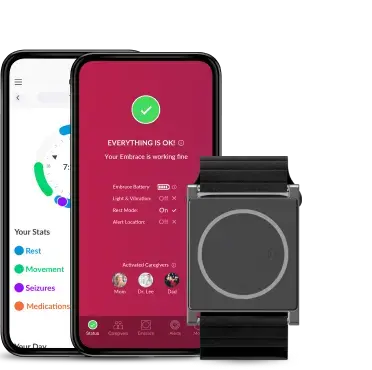Measuring speaking anxiety of English language learners with the E4
This blog article has been guest-authored by Heera Lee, a Ph.D. candidate in the Human-Centered Computing program at the University of Maryland Baltimore County (UMBC), whose work focuses on the areas of affective computing and education. Her dissertation, outlined in this article, examines ways to support English language instructors to provide personalized emotional and instructional scaffolding, by determining levels of anxiety among English language learners when delivering presentations.
Language instructors often assign tasks such as presentations to evaluate communication skills among English language learners (ELLs). However, delivering a presentation in a non-native language has been reported as one of the most anxiety-provoking tasks faced by ELLs [1]. Difficulties are often encountered by instructors when attempting to identify anxiety among students, as it may not necessarily be obvious from facial expressions or behaviors. Instructors may also be unfamiliar with cultural norms among students, and, as a result, may misinterpret the silence or passive participation in class activities. Unless ELLs explicitly disclose feelings of anxiety, the process of detecting emotional states continues to pose a challenge to instructors.
Wearable sensor technologies have been shown to offer considerable potential to monitoring and understanding the wearer’s emotional state [2]. However, these technologies have yet to be broadly utilized within a classroom setting. Studies have yet to examine the impact of these technologies with ELLs (including deaf and hard of hearing learners).
Our early studies have shown that English instructors were able to use the data presented by biosensor technology, as an objective reference to evaluate the emotional states of the ELLs. However, to assist instructors to efficiently perceive the emotional states of the ELLs in class, we aimed at classifying the degree of anxiety and identifying the predominant types of anxiety (e.g.": public speaking anxiety (PSA), foreign language anxiety (FLA), both, or none) experienced when delivering presentations. We conducted our studies in intermediate-level Speaking and Listening classes at the English Language Institute (ELI) at UMBC. We used the Empatica’s E4 wristband to record the physiological data of each ELL when delivering bi-monthly presentations in class. These presentations were required as part of the class.
The E4 wristband provided a lightweight, non-invasive method of gathering continuous and real-time physiological data from the students.
Other studies examining anxiety have used technologies such as Electroencephalography (EEG) sensors, wearable computers featuring a head-mounted display, or locating many video/audio cameras in front of a presenter to record facial expressions and body gestures, all of which take time to set-up. On the days when presentations were delivered, participating students wore the E4 wristband on their non-dominant wrist. While the E4 wristband records multiple physiological signals (e.g., blood volume pulse, skin temperature, etc.), electrodermal activity (EDA) was selected for our analysis because arousal identified in EDA have been shown to be indicative of anxiety in prior studies [3-4]. We adopted a mixed-method approach in our research. Qualitative methods including questionnaires and interviews were combined with behavioral cues (e.g., eye contact/gaze, pauses, and filler words) and EDA data to better understand the emotional states of language learners. We used machine learning algorithms to explore patterns of EDA, characterizing degree and subtypes of anxiety that the ELLs may experience during their oral presentation [5-6-7-8].
Our studies showed that prominent EDA features in k-means clustering can classify students into a higher and lower level of anxiety group. Moreover, the gradient boost tress (GBT) classifier performed well in predicting the predominant type of anxiety among ELLs based upon different EDA feature sets.
From the results of these studies, we were able to demonstrate the potential of using EDA features to let English language instructors be aware of the emotional states of the ELLs, especially in terms of the intensity and subtypes of anxiety while delivering a presentation in class.
We’re currently developing an educational system to support English instructors identify the predominant type of speaking anxiety along with its degree across the ELLs. In an effort to develop the system that better matches instructors’ needs, the English language instructors from the UMBC ELI were invited to a professional development session where we asked them to sketch prototype systems using sensing technology, which can identify anxious students and offer the possibility of modifying their instruction. The instructors also described functions and interactivity that would be useful.
To evaluate the efficacy of an initial educational system, novice and experienced English instructors will be recruited to evaluate the emotional states of ELLs. During the interview, they will compare the use of traditional methods of determining anxiety among students (e.g., observational data) to data presented via the new system.
We foresee the promise of using the E4 wristband in ESL/EFL classes to assist English instructors to detect anxiety among students. These would include ELL deaf and hard of hearing students whose anxiety may be harder to detect when using American Sign Language alongside an interpreter to voice content from presentations. The biosensor-based feedback from the E4 wristband can be an effective method of communicating anxiety in ESL/EFL classes.
The E4 wristband, mentioned in thousands of research papers, and equipped with a PPG sensor, EDA sensor, 3-axis accelerometer, and infrared thermopile, collects real-time physiological data, which can be used to conduct in-depth analysis and visualization. You can learn more about the E4 wristband by visiting our website or getting in touch with us at research@empatica.com.
References
- Kasbi, S., & Shirvan, M. E. (2017). Ecological understanding of foreign language speaking anxiety: emerging patterns and dynamic systems. Asian-Pacific Journal of Second and Foreign Language Education, 2(1), 1-20.
- Croft, R. J., Gonsalvez, C. J., Gander, J., Lechem, L., & Barry, R. J. (2004). Differential relations between heart rate and skin conductance, and public speaking anxiety. Journal of behavior therapy and experimental psychiatry, 35(3), 259-271.
- Schwerdtfeger, A. (2004). Predicting autonomic reactivity to public speaking: don't get fixed on self-report data!. International Journal of Psychophysiology, 52(3), 217-224.
- Sevinç, Y. (2018). Language anxiety in the immigrant context: Sweaty palms?. International Journal of Bilingualism, 22(6), 717-739.
- Lee, H., & Kleinsmith, A. (2019, May). Public speaking anxiety in a real classroom: Towards developing a reflection system. In Extended Abstracts of the 2019 CHI Conference on Human Factors in Computing Systems (pp. 1-6).
- Lee, H., Mandalapu, V., Kleinsmith, A., & Gong, J. (2020, July). Distinguishing Anxiety Subtypes of English Language Learners Towards Augmented Emotional Clarity. In International Conference on Artificial Intelligence in Education (pp. 157-161). Springer, Cham.
- Lee, H. (2020, October). Supporting Instructors to Provide Emotional and Instructional Scaffolding for English Language Learners through Biosensor-based Feedback. In Proceedings of the 2020 International Conference on Multimodal Interaction (pp. 733-737).
- Lee, H., Mandalapu, V., Gong, J., Kleinsmith, A., & Kuber, R. (2020, October). Using Physiological Cues to Determine Levels of Anxiety Experienced among Deaf and Hard of Hearing English Language Learners. In Companion Publication of the 2020 International Conference on Multimodal Interaction (pp. 72-76).
We do not guarantee that EpiMonitor will detect every single seizure and deliver alerts accordingly. It is not meant to substitute your current seizure monitoring practices, but rather to serve as a supplement in expediting first-response time.



